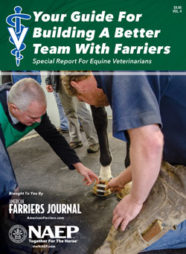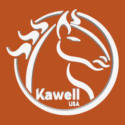
American Farriers Journal opened communications between farriers, manufacturers and supply shops, says Steve Kraus, Cornell University's head of Farrier Services. “If there’s one thing that unifies the profession, it’s a trade journal like American Farriers Journal,” he says. Image: Jeff Cota
Editor’s Note: American Farriers Journal is celebrating its 50th anniversary and we’re reflecting on the relationships and partnerships we’ve forged, the milestones and the lessons we’ve learned along the way. In the famed Christmas movie “It’s a Wonderful Life,” protagonist George Bailey gets to see, via a dramatic intervention by an angel named Clarence Oddbody, what the world might have been like had he never been born. International Horseshoeing Hall of Fame member Steve Kraus, Cornell University’s head of Farrier Services and senior lecturer of large animal surgery, offers his thoughts on what the farrier industry would be like if it never existed.
In the early 1970s, Western Horseman magazine was the only place I saw anything about farriery. They had some basic articles, but that’s where I first saw an advertisement for the American Farrier’s Association (AFA).
When Henry Heymering came along with American Farriers Journal (AFJ), that was the only thing that focused on hoof care. Right around then is when Doug Butler published his first book, the Principles of Horseshoeing, which hit big.
The Michigan Horseshoers Association held a yearly clinic back then. I drove there with Doug Butler, Buster Conklin, Harold Mowers and my friend Doug Pokorney. Imagine being a young farrier absorbing the wisdom of these people during an 8-hour trip.
The Garden State Horseshoers Association and the Pennsylvania Guild of Professional Farriers held yearly contests in the early ’70s. The first contest I went to was at the Garden State Horseshoers Association and that’s where I met Bruce Daniels. I had to compete against him as a greenhorn, but I didn’t do too badly against some of the other farriers.
We heard about this guy Bruce, and he really put on a show. Even back then, he set up a little tent to work under. He had it all. He had a better forge, and everybody wanted to watch Bruce Daniels. There were other fancy people there, too, like Walt Koepisch and Bob Reaume, who ran Wolverine Farrier School in Michigan. That was a blast. We had a good time.
What was nice about American Farriers Journal is that you found out about these things and you saw the results. I had a good relationship with Henry because he would be around at some of these events.
The Realm of the Horseshoer
Doug Butler and I wrote an article for American Farriers Journal in March 1977. We both experienced a lot of pushback, in which veterinarians and farriers were not getting along. Farriers were blamed for things that weren’t their fault.
The article is a compilation of real things that happened to either me or him that were conflicts with veterinarians who were not competent about horses’ feet and shoeing. That’s why we called it “The Realm of the Horseshoer.” This is our job. They don’t teach enough about feet in veterinary school.
Generally, vet-farrier relations have improved. There are still little glitches here and there. I don’t experience it because I have a lot of respect at Cornell. I’ve been at Cornell for 15 years and no one’s ever told me how to shoe a horse. They ask me what I think of this, and we hash it out. Even before that, I got along with all the vets in the area.
Where we run into trouble is when a veterinarian who thinks they know the theories and wants to apply them to the wrong horse. Or, it’s not practical for this particular horse. That’s where we get too much of, “Shorten the horse’s toe and raise its heel.”
I try to be philosophical in those situations. I’ll say, “Here’s something that doesn’t seem to be working. Let’s give this a try.” I see more shoeing jobs now than ever before. When I see a really nice job, I compliment it. I tell the owner, “Wow, whoever you have for a farrier, keep him. Don’t let him get away because he’s doing a really nice job on this horse.”
Sometimes the farrier either doesn’t know what the horse’s problem is, they don’t have the diagnostics, or the horse has injured itself. But the issue is not because of the way the horse is shod. I might also say, “The farrier is doing a nice job, but here’s how we need to tweak it to make it better.”
That’s how I approach it and that’s how I want somebody to approach my work. Treat others the way you’d like to be treated, is the way I think of it.
When we see when a terrible job comes in, I tell the students, “We weren’t there when this horse was shod. We don’t know what this foot looked like. We really don’t know how long the shoe was on. Right now, it’s too small for this foot, but was it the right size when the horse was shod?” Or if it’s a rough job, you might want to say, “We don’t know how poorly this horse stood.” We’ve all been there when we’d like to do a really good job every time, but sometimes the behavior or what’s going on with the horse gets in the way. As even Doug Butler would say, “We got iron on all four feet and we lived.”
It's nice to be able to do that perfect job that you’d be happy to put in a contest on every horse, but sometimes the reality is not that way. I don’t think that’s ever going to change.
What if …
Early on, AFJ provided a means to advertise forging contests, report the results and provide some articles of interest. The few manufacturers that were around always advertised. At the time, the farrier profession was very disjointed. You had these few small events. You had, in some cases, farriers not talking to each other. The AFA wasn’t very well known. I didn’t join the AFA until 1977. I was aware of it, but I didn’t see any need to join. They didn’t project themselves well. My attitude was, “What are you going to do for me?”
Also, at the same time, the small group of companies that dominated the manufacturing side had no stimulus to do better than they were doing. Capewell had quality problems. Diamond would sell shoes, whether they did anything or not, they made feeble attempts, but they knew they were going to sell everything they could produce and made very few changes.
None of these companies had any technical assistance from farriers. I was one of the first farriers to work for a big company — Mustad — that was on staff to help them. What AFJ did was, Henry turned on a light for farriers to see beyond their small circles that they were in. With the AFA being in its early stages, and these small groups like Michigan and Garden State horseshoers, they were small circles that were very disjointed. The companies made feeble attempts to sponsor events, or put in a showing or send something.
As AFJ turned on this light, so to speak, the farriers became interested in their profession. When this publication came out, they showed what the other guys are doing, what’s happening here and there, and so on. That, and attending my first AFA Convention in 1977 with Mustad, made a difference of spurring the growth of the profession during those years.
In that timeframe, with Henry and then Dean Laux buying AFJ, the industry started picking up. Between 1975 and the 1990s, there was no internet. The main way you could advertise and talk to the profession was through American Farriers Journal. That’s when farriery started gaining traction.
Manufacturers definitely benefited because now they had a way to reach everybody easier. As the profession grew, there became a certain division at times between farrier groups. With the emergence of the International Association of Professional Farriers, I think American Farriers Journal helped stitch everything together. There was a certain amount of controversy at the time between the AFA and the IAPF that American Farriers Journal basically helped people realize that we are all one profession, and there’s not much division.
If there’s one thing that unifies the profession, it’s a trade journal like American Farriers Journal. Farriers should be members of the associations, but you don’t have to be a member to get information. I encourage farriers to join one or both national organizations or their state group. American Farriers Journal is politically neutral. That’s very important in this industry.
AFJ has been the only true trade magazine publishing all ideas and content.
Related Content: [Video] American Farriers Journal Unifies the Industry
Read more from "What If American Farriers Journal Didn't Exist?"
What do you think? Where would the farrier industry be if American Farriers Journal never came to be? Share your thoughts by emailing jcota@lessitermedia.com.







